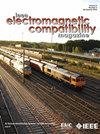基于连通频率选择表面的雷达吸波材料设计
IF 2.5
3区 计算机科学
Q3 ENGINEERING, ELECTRICAL & ELECTRONIC
IEEE Transactions on Electromagnetic Compatibility
Pub Date : 2025-03-13
DOI:10.1109/TEMC.2025.3564363
引用次数: 0
摘要
本文推导了雷达吸收材料(RAM)的设计准则,该材料集成了连接的、鱼网状的、电阻频率选择表面(r - fss)。虽然r - fss长期以来一直用于雷达信号和减少电磁干扰,但所有单元物理连接的配置尚未为此目的进行彻底的研究。事实上,鱼网状的布局可以保证ram制造方面的非凡关键优势,特别是在大规模生产时。因此,本文通过大量的测试案例,旨在推导出实用的设计程序,以实现相邻FSS单元之间的有利连接。具体而言,深入探讨了单元连接中几何变化对FSS整体阻抗行为的影响。为了确保所提出的指导方针的广泛适用性,该研究已根据传输线理论和精确的全波模拟,通过重复等效电路分析进行。为了证明所制定的指导方针的实际意义,已经制作了两个基于电阻和连接FSS的相同RAM原型。在小型平板和大规模共形排列中,在6至18 GHz频段内的电磁反射都大大减少,同时大大简化了制造工艺。总之,通过解决与连接单元电池设计相关的困难,所提出的研究显示出有希望实现ram的高效大规模制造的潜力。本文章由计算机程序翻译,如有差异,请以英文原文为准。
Design of Radar Absorbing Materials Based on Connected Frequency Selective Surfaces
This article derives design guidelines for radar absorbing materials (RAM) integrating connected, fishnet-like, resistive frequency selective surfaces (R-FSSs). While R-FSSs have been long used in the radar signature and electromagnetic interferences reduction, nevertheless the configuration where all the unit-cells are physically connected has not been yet thoroughly investigated for this aim. Indeed, the fishnet-like arrangement can guarantee extraordinary key advantages in terms of RAMs fabrication, especially for large production scales. Therefore, this article, by resorting to significant test-cases, aims at deriving practical design procedures to realize advantageous connections among adjacent FSS unit-cells. Specifically, the effects on the overall FSS impedance behavior of the geometrical variations in the unit-cell connections are deeply explored. To ensure the broad applicability of the presented guidelines, the study has been carried out by recurring to an equivalent circuit analysis, based on the transmission line theory, and on accurate full-wave simulations. To prove the practical significance of the developed guidelines, two prototypes of the same RAM based on a resistive and connected FSS have been fabricated. Both in a small flat panel and in a large-scale conformal arrangement, the electromagnetic reflection was drastically reduced in the band between 6 and 18 GHz, while significantly simplifying the fabrication process. In conclusion, the proposed research exhibits promising potential to enable an efficient large-scale fabrication for RAMs, by addressing the difficulties associated with the design of connected unit-cells.
求助全文
通过发布文献求助,成功后即可免费获取论文全文。
去求助
来源期刊
CiteScore
4.80
自引率
19.00%
发文量
235
审稿时长
2.3 months
期刊介绍:
IEEE Transactions on Electromagnetic Compatibility publishes original and significant contributions related to all disciplines of electromagnetic compatibility (EMC) and relevant methods to predict, assess and prevent electromagnetic interference (EMI) and increase device/product immunity. The scope of the publication includes, but is not limited to Electromagnetic Environments; Interference Control; EMC and EMI Modeling; High Power Electromagnetics; EMC Standards, Methods of EMC Measurements; Computational Electromagnetics and Signal and Power Integrity, as applied or directly related to Electromagnetic Compatibility problems; Transmission Lines; Electrostatic Discharge and Lightning Effects; EMC in Wireless and Optical Technologies; EMC in Printed Circuit Board and System Design.

 求助内容:
求助内容: 应助结果提醒方式:
应助结果提醒方式:


